#peru river scene
Text
promise

#transformers rise of the beasts#transformers#tf#tf rotb#rotb#mirage#rotb mirage#peru river scene#messed around with blue and green#look at his kissable lips (✷‿✷)#i love him so much#I LOVE MIRAGE SO MUCH AAAAAAA#4th illustration ive done#infinite painter#my art
280 notes
·
View notes
Text


This vessel is modeled in the shape of a spiral platform surmounted by an open-sided structure with a figure inside. The vessel itself is a bottle, with a spout in the shape of a stirrup, a characteristic shape on Peru’s north coast from the first millennium B.C. through the later part of the first millennium A.D. The spiral platform is ornamented with a procession of snails, sculpted in high relief, and felines, painted in red slip, ascending to the summit where a figure is depicted within a four-posted, roofed structure on a circular podium. The figure wears a conical headdress, ear ornaments, and a beaded collar, and holds a war club across his chest.
Finely made and delicately painted, this bottle would most likely have been used in Moche ceremonial contexts before its ultimate deposition in a burial. The Moche culture flourished on Peru’s north coast from A.D. 200 to 800. Powerful men, and sometimes women, ruled over regional centers in the fertile river valleys of this otherwise arid desert region. Moche sites were characterized by monumental pyramidal platform mounds made of mud brick, often ornamented with polychrome reliefs. Moche artists were renowned for their achievements in metallurgy as well as for their sophisticated ceramic traditions featuring ritual and mythological scenes.
Modeled and painted ceramic bottles were a favored form for Moche artists, as they were for their predecessors, the Salinar and the Gallinazo cultures. Of the thousands that have survived to the present day, several hundred feature architectural structures. Some emulate monumental platform mounds, occasionally with a figure at the summit, while others focus on a specific structure located within a larger complex. A number of Moche vessels depict spiral platforms, but actual spiral platforms are fairly rare in the archaeological record. A notable example of a monumental spiral platform was excavated at the site of Moche, on the plain between the two architectural complexes of Huaca del Sol and Huaca de la Luna.
Few architectural vessels have been excavated under controlled conditions, but of those that have, they have been found in both middle- and high-status burials of adult women, young males, adolescents, and children. Some have been found in burials close to ritual architecture, and the representations themselves often refer to processional ways and places of sacrifice. This effigy perhaps served as an emblem of the power and potential of the sacred architecture it emulated.
Joanne Pillsbury, 2015
https://www.metmuseum.org/art/collection/search/308415
10 notes
·
View notes
Text
The Top Country to Visit on Each Continent

Entrepreneur Spencer Schar has been fortunate enough to visit every continent except Antarctica, traveling to 24 countries to date for business and pleasure. This article will showcase some of the world’s most spectacular travel destinations, featuring a country from every continent.
Canada (North America)
Canada is a vast country that boasts some incredible sights. From Yosemite in the north to Banff National Park in the south, the country is home to some of the most breathtaking scenery on the planet.
Peru (South America)
Nestled high in the breathtaking Andes Mountains, the ancient city of Machu Picchu is an ancient archaeological site that attracts millions of visitors each year. Jam-packed with Incan temples, terraces, towers, and more – many of which defy the laws of engineering due to their mortar-free construction – Machu Picchu is not just a cultural hotspot but also one of the most breathtaking locations on the planet.
Spain (Europe)
With its sun-soaked beaches, history, culture, fine wine, and mouthwatering cuisine, Spain has something for everyone. While the cosmopolitan metropolises of Madrid and Barcelona are renowned for their cultural scene and arts, the historic cities of San Sebastian, Granada, and Seville are brimming with old-world charm and architectural heritage.
Egypt (Africa)
Home to the mighty River Nile and the Pyramids at Giza, one of the world’s earliest man-made structures still standing, Egypt features prominently on the bucket list of many seasoned travelers. For those interested in archaeology, cities like Luxor, Cairo, and Aswan are the ultimate destination, brimming with ancient ruins, hieroglyphs, and artefacts.
Thailand (Asia)
With its sugar-white sands and palm-fringed emerald waters, Thailand is a tropical paradise. In addition, ancient Buddhist temples await, along with luxury hotels, delicious food, and a myriad of rare and interesting wildlife.
Australia (Oceania)
Australia boasts more than its fair share of stunning sights, from the underwater paradise of the Great Barrier Reef to Sydney’s striking harbor. Spanning more than 2.9 million square miles and six time zones, the country is vast and diverse. For those on a self-drive adventure, the Great Ocean Road in Victoria is one of the most scenic roads in the world. Stretching more than 300 kilometers from Torquay to Allansford, the road skirts the rugged southwest coastline, providing dramatic views of the Twelve Apostles rock formations.
Winter Paradise (Antarctica)
The South Pole is usually the first location that comes to mind when people think of Antarctica. However, travelling to this iconic destination is not for the fainthearted. Incredibly beautiful, albeit with a sub-zero climate, Antarctica is home to some stunning scenery, which can best be appreciated at Winter Paradise, with its calm waters and vast icebergs. Nothing short of magical, on a summer’s day, visitors enjoying a tour of the icebergs can watch leopard seals basking in the sun and albatross gliding across the skies.
0 notes
Text
Beyond Accommodation: The Unique Experiences Offered by The Park Holidays

When planning a vacation, finding a comfortable place to stay is just the beginning. The real essence of travel lies in the experiences that one gathers as he goes along. This is well understood by The Park Holidays International which has gone beyond mere accommodation. They create unique and fulfilling experiences that ensure that your trips are unforgettable. From cultural immersion to thrilling adventures, The Park Holidays international reviews continue to reveal diversity and memorable experiences. Here’s how The Park Holidays International review shows off differentiating extraordinary encounters.
Cultural immersion
A significant feature of The Park Holidays International is their emphasis on cultural immersion. By offering deeper and more authentic experiences they give chances for tourists to delve into local culture.
Local Festivals and Events
Frequently, The Park Holidays International matches up vacations with local festivities and happenings for members to engage in customary ceremonies. Whether it’s the vibrant colors of Holi in India, the serene beauty of the Lantern Festival in Thailand, or the grandeur of Carnival in Brazil these experiences offer us insight into what it means to live like a local.
Culinary Experiences
The Park Holidays international reviews often praise the food moments provided by this company since food plays an imperative role in defining cultures within a society such as India. Travelers can taste original dishes or have a chance to prepare them through guided food tours, and cooking classes with local chefs among other activities introduced by this firm. Just think of making traditional Italian meals at Tuscany or exploring the Bangkok street food scene — all these are possible with The Park Holidays International.
Art and Craft Workshops
Art and craft workshops enable people to immerse themselves in the local culture too. Local craftsmen usually guide members through hands-on workshops organized by The Park Holidays International. You can easily be able to make out pottery from Japan, batik painting from Indonesia or even weaving from Peru thereby having something you have made yourself and appreciation for the local artistry.
Adventure and Exploration
The Park Holidays International has a wide range of activities that cater to adventurous individuals or those seeking a thrill.
Outdoor Adventures
The Park Holidays international reviews often identify different outdoor adventures accessible by members. In this case, these guided hikes and treks take you through the Himalayas or Costa Rica’s lush forests, providing an opportunity to explore the natural world, safely. For instance, water enthusiasts can participate in snorkeling at The Great Barrier Reef; surf at Bali, or even enjoy white-water rafting at the Colorado River.
Wildlife Safaris
This is a unique experience where clients watch animals in their habitats. The Park Holidays International organizes safaris in renowned national parks as well as wildlife reserves. For example, such great migrations include spotting the Big Five of Africa, tracking tigers in India’s Ranthambore, or observing orangutans on Borneo among others.
Wellness and Relaxation
Vacations are also a time to relax and rejuvenate, and The Park Holidays International excels in offering wellness experiences that promote physical and mental well-being.
Spa and Wellness Retreats
These luxurious spas and wellness retreats are highly recommended by The Park Holidays international reviews. At these retreat centers, they offer various services like massages, facials, yoga sessions as well as meditation classes. Some destinations popular for their holistic wellness practices and tranquil atmospheres include Bali, Thailand besides India specifically.
Nature Getaways
(The Park Holidays International) offers access to serene retreats at some of the most beautiful places on earth for those who want to commune with nature again. They include, for instance, Swiss Alps cabins, Maldives seafront villas, or Canada forest lodges offering peace as well as opportunities to relax surrounded by nature.
Family-Friendly Activities
When you are traveling with your family, be ready for a hard experience but The Park Holidays International simplifies it by providing a range of services that cater to all ages.
Amusement Parks and Attractions
Several The Park Holidays international reviews have cited partnerships between the company and various global theme parks. For example, a trip to Disneyland in California or Universal Studios in Singapore will guarantee thrilling rides, entertaining shows, and meeting different characters.
Educational Visits
Families can explore and learn at the same time through educational tours. The firm arranges visits to museums, science centers, or even historic sites such as the Smithsonian in Washington DC; the British Museum in London; and the ancient ruins of Machu Picchu in Peru among others which are fun and informative.
Exclusive Member Events
These events bring together members who may socialize or network with other travelers thus they are important activities that The Park Holidays International organizes.
Gala Dinners and Parties
Many The Park Holidays international reviews mention gala dinners and themed parties as one of their highlights. These take place at scenic spots with gourmet meals being served accompanied by live performers making it feel like party time. This might be an island beach party somewhere around the Caribbean or it could be a formal dinner in a European castle bringing more glamour into the vacation experience.
Workshops and Seminars
Interested individuals will find workshops in different areas organized by The Park Holidays International. Wellness programs cooking sessions photography classes money matters led by experts can also be sourced from here. In addition, they get new skills and valuable connections since they interact with the like-minded.
Sustainable Tourism Initiatives
The Park Holidays International, given the growing importance of sustainable tourism, is committed to promoting responsible travel.
Eco-Friendly Accommodations
According to numerous The Park Holidays international reviews, the firm has chosen to work with environmentally conscious hotels and resorts. These accommodations have green initiatives such as power saving, waste management, and eco-friendly products. This way members can enjoy lavish stays while lessening their ecological impact.
Community Support Programs
Besides this, there are several other contributions that The Park Holidays International makes towards supporting local communities. They relate to using local staff, sourcing from local suppliers, or contributing towards community development programs. What’s more, travelers can always visit these projects and witness the positive transformation that results from each stay.
Tailored Itineraries and Concierge Services
One particular attribute that sets The Park Holidays International apart is its personalization approach when it comes to trip planning. The firm offers concierge services that ensure that all vacation aspects are customized according to the individual preferences of their customers.
Personalized Vacation Packages
Since you make your reservation, The Park Holidays International takes the initiative of designing a vacation package that is personalized and has all your favorite activities, dining options as well as sightseeing. You could be interested in a Napa Valley wine-tasting tour, a historical exploration of Rome, or rather Maldives beach relaxation which will be planned into the itinerary to guarantee an enjoyable holiday experience.
Exclusive Concierge Services
For every aspect of your journey, The Park Holidays International has committed concierge services. Do you need assistance with booking a dinner table for two? Would you like to organize transport around town? Or do you have some special requests? Anything can be done by the team of concierges who are available at any time of day or night so that you don’t worry during your rest.
Conclusion
Apart from providing accommodation, The Park Holidays International offers different experiences to various types of tourists. The travel company consistently rated among the best in terms of offering cultural immersion adventure traveling wellness activities family fun exclusive occasions sustainable trips Park Holidays International reviews show it does more than just provide unique and memorable experiences for its customers by prioritizing personalization quality accommodation and customer satisfaction Through delivering what is expected from each trip while maintaining personalized service high-quality accommodations and customer satisfaction The Park Holidays International. It is therefore not merely a vacation but a tour full of unique moments that guests should experience and cherish.
The Park Holidays International Lets one see beyond ordinary vacations into amazing adventures. They offer everything from culinary tours and cultural festivals to wildlife safaris and wellness retreats — The Park Holidays International review. Get ready for your next dream trip enriched by those rare moments that go beyond imagination!
#park holidays international#park holidays international reviews#the park holidays#The Park Holidays International#The park holidays international reviews#the park holidays reviews
0 notes
Text
Explore the Rich Diversity of Chile with Sita Tours' Unforgettable Vacation Tours

Nestled between the Andes Mountains and the Pacific Ocean, Chile is a land of breathtaking natural beauty, rich cultural heritage, and diverse landscapes waiting to be discovered. With Sita Tours' Chile vacation tours, embark on an extraordinary journey through this captivating destination and immerse yourself in its wonders.
Scenic Wonders:
Chile boasts an array of stunning natural landscapes, from the arid Atacama Desert in the north to the rugged fjords and glaciers of Patagonia in the south. Our vacation tours offer the opportunity to explore these diverse regions, taking in the otherworldly beauty of the Atacama Desert, the pristine wilderness of Torres del Paine National Park, and the majestic peaks of the Andes.
Cultural Experiences:
Experience the vibrant culture and rich history of Chile as you visit charming colonial towns, vibrant cities, and traditional villages. Discover the colorful street art of Valparaíso, explore the historic neighborhoods of Santiago, and immerse yourself in the indigenous traditions of the Mapuche people.
Wine Tasting:
No visit to Chile is complete without sampling its world-renowned wines. Our vacation tours include visits to some of Chile's most prestigious wineries, where you can tour the vineyards, learn about the winemaking process, and indulge in tastings of award-winning wines, including the iconic Carménère.
Adventure Activities:
For thrill-seekers and outdoor enthusiasts, Chile offers a wealth of adventure activities to enjoy. Whether it's hiking in the Andes, whitewater rafting in the Maipo River, or skiing in the pristine slopes of the Andean resorts, our vacation tours cater to adrenaline junkies of all levels.
Local Cuisine:
Savor the flavors of Chilean cuisine as you dine on fresh seafood, hearty stews, and delectable desserts. Our vacation tours include opportunities to sample traditional dishes such as ceviche, empanadas, and pastel de choclo, as well as to experience the vibrant street food scene in bustling markets and food stalls.
Expert Guides and Support:
Throughout your Chile vacation tour, our experienced guides and support staff will be on hand to ensure a seamless and unforgettable experience. From arranging transportation and accommodations to providing insider tips and recommendations, we are dedicated to making your journey as enjoyable and stress-free as possible.
More Details:
Peru Luxury Tours From USA
Spain Family Tours
South Africa Luxury Tours From USA
Tours To Morocco From USA
Tanzanian Wildlife Experience From USA
Conclusion:
With its stunning landscapes, rich culture, and diverse experiences, Chile is a destination like no other. Whether you're seeking adventure, relaxation, or cultural immersion, Sita Tours' Chile vacation tours offer the perfect way to discover all that this incredible country has to offer. Contact us today to book your Chile vacation tour and start planning the adventure of a lifetime.
0 notes
Text
The Moche culture developed in the coastal region of Peru, mainly between the 1st and 8th centuries AD.
It flourished in the area known as the Moche Valley, along the Chicama and Moche river valleys, notable for its art, architecture, ceramics, and complex social organization.
It is one of the most distinct and sophisticated of pre-Columbian civilizations.
His pieces portray everyday life, human figures, animals, gods and mythological scenes with great detail and realism.
The Mochicas were also skilled metalworkers, producing gold and silver objects with great mastery.
They built pyramidal temples in adobe, such as the Huaca del Sol and the Huaca de la Luna.
These structures were ceremonial and administrative centers, covered with elaborate mural decorations.
Hierarchical society, with a ruling elite, priests and distinct social layers.
Advanced agricultural system, with irrigation and land cultivation techniques. They also demonstrated a remarkable mastery of fishing and navigation, and a rich mythology and religious practices.
Many of the artistic representations and ceramics show divine figures and rituals related to them.
The Mochica culture disappeared around the 8th century AD, long before the arrival of the Spanish conquerors.
The sophistication of this civilization continues to be studied and admired to this day.
Mochica Culture
Sources: Arqueologos Trujillo, Adrian Alejandro Mendoza
edisonmariotti @edisonblog
.br
A cultura Moche, desenvolveu-se na região costeira do Peru, principalmente entre os séculos I e VIII d.C.
Floresceu na área conhecida como Vale de Moche, ao longo dos vales dos rios Chicama e Moche, destacando-se por sua arte, arquitetura, cerâmica e complexa organização social.
É uma das mais distintas e sofisticadas das civilizações pré-colombianas.
Suas peças retratam a vida cotidiana, figuras humanas, animais, deuses e cenas mitológicas com grande detalhamento e realismo.
Os mochicas também eram habilidosos metalúrgicos, produzindo objetos de ouro e prata com grande maestria.
Construíram templos piramidais em adobe, como a Huaca del Sol e a Huaca de la Luna.
Estas estruturas eram centros cerimoniais e administrativos, cobertas com elaboradas decorações murais.
Sociedade hierarquizada, com uma elite governante, sacerdotes e camadas sociais distintas.
Sistema agrícola avançado, com técnicas de irrigação e cultivo de terras. Também demonstraram um domínio notável na pesca e navegação, e uma rica mitologia e práticas religiosas.
Muitas das representações artísticas e cerâmicas mostram figuras divinas e rituais relacionados a elas.
A cultura Mochica desapareceu por volta do século VIII d.C., muito antes da chegada dos conquistadores espanhóis.
A sofisticação dessa civilização continuam a ser estudadas e admiradas até hoje.
Cultura Mochica
Fuentes: Arqueologos Trujillo, Adrian Alejandro Mendoza

1 note
·
View note
Text
Ecuadoreans will this weekend choose between a centre-right presidential candidate who is the scion of one of country’s wealthiest families, and a leftist disciple of the former president Rafael Correa, in an election overshadowed by violent crime and the assassination of a third candidate.
Polls ahead of Sunday’s vote put the banana industry heir Daniel Noboa, 35, slightly ahead of Luisa González, who has promised free medicine and increased worker protections.
Both presidential candidates have promised to militarise ports and airports to fight drug trafficking as headline-grabbing violence becomes ever more brutal and commonplace, particularly in coastal regions around the port cities of Guayaquil, Manta and Esmeraldas, where gangs vie for territory and trafficking routes with the backing of Mexican cartels.
The campaign has been marked by bloodshed, including the brazen assassination of the anti-corruption candidate Fernando Villavicencio, who was shot in August as he left a campaign event. Last week, six Colombian suspects in the assassination were themselves murdered in prison. A seventh suspect was killed in another jail the following day.
In just a few years, Ecuador has gone from being an island of peace compared to its cocaine-producing neighbours, Colombia and Peru, to becoming one of the most violent nations in the region.
At more than 5,900, the number of murders so far this year has already surpassed records from previous years. More than a third of those killings were committed in the Guayas region around Guayaquil, Ecuador’s largest city.
Just on Wednesday, there were five street killings in Durán, a riverside district lying east of Guayaquil just across the Guayas River. Warring gangs have turned this neighbourhood, crippled by protection rackets, into a battlefield of tit-for-tat murders.
At the scene of one such attack, the bodies of two men lay crumpled on a fallen motorbike after they were ambushed in broad daylight.
Behind a line of yellow police tape, a crowd gathered, some distraught relatives, others curious bystanders.
An anguished wail went up as the mother of one of the victims arrived, her whole body shaking as she sobbed. Another older woman was held back as she strained to push past the tape.
“Let me pass, he’s my son. Just let me hug him one last time,” she implored an impassive police officer, as a forensic van pulled up and hazmat-suited officials marked out a dozen bullet casings with numbered yellow plastic blocks.
“A year ago, we lived in peace. Now the people are terrified,” said one onlooker, who did want to be identified. “People shut up their shops early, they don’t let their kids out to play anymore.”
Ecuador’s national anti-narcotics director, Gen Pablo Ramírez, insisted the country is not a lost cause. “This is not a lost war,” he told the Guardian, but he said it was not an equal fight. “We fight in unequal circumstances, [the gangs] have more weapons and money and we are constrained by the rule of law.”
The country’s most powerful criminal group, Los Choneros, splintered in 2020 with the killing of its leader Jorge Luis Zambrano, alias Rasquiña, spawning a web of rivals – the Lagartos, Tiguerones and Chone Killers to name a few.
Run from inside and outside prison, the gangs have complex alliances with Mexican factions such as the Sinaloa and Jalisco Nueva Generación cartels, as well as Colombian guerrilla groups and Balkan traffickers.
The battle for control used to play out in the immense El Litoral prison complex on the outskirts of Guayaquil, the site of a string of grisly riots and massacres. But now the fighting has spilled onto the streets.
“Organised crime is a parallel state in Ecuador; they have taken the judiciary, the legislature, they are even in the political parties, they are everywhere,” said Arianna Tanca, a political scientist and researcher in Ecuador.
“They have much more power than the president, much more resources, much more money and they have the weapon of fear,” she said.
Built on islands in the delta of the Guayas River, Guayaquil is a shifting landscape of shiny high-rise buildings, luxurious gated communities and riverside slums wracked by crime and neglect.
The waterways provide rich drug smuggling possibilities and the city’s ports – mainly designed for the export of bananas – had “poor controls”, admitted Ramírez. He added scanners were being installed, which he said would be able to inspect 100% of exports by the middle of next year.
The police had stopped more drugs so far this year than any before, seizing 172 tonnes of mostly cocaine, 55 tonnes of which was seized at ports, he added.
Last month, in one of those poor neighbourhoods, Joaquín Pérez, 11, was sitting on the pavement, drinking a soda with friends and neighbours when motorbike-riding gunmen opened fire with an automatic weapon. Joaquín was hit by more than 30 rounds.
“I saw him on the floor. I thought it was just one bullet and I went running to pick him up and take him to the hospital,” sobbed his sister Gema Pérez, 23.
Three adults were killed in the attack, and six people – including two girls aged five and eight – were injured. Police believe the gunmen’s target may have been a neighbour who escaped unharmed and later fled.
“[Joaquín] was my special boy. Now it’s so quiet here without him,” she said, sitting in a one-storey breeze-block home, as other relatives cried softly in the gloom.
“My nephew was the hope of the household, he was going to be the one who would graduate, study, get ahead – but that dream was cut short,” said an uncle, Alex Peréz, 42.
The daily toll of victims has focused attention on Ecuador’s flailing political class, locked in rivalries and infighting, and apparently incapable of reining in the violence.
“Whoever wins, I hope they try to work with the other one,” said Tanca, the analyst. “Politicians are fighting each other about nonsense, but every day Ecuadorean people are dying in the street.”
0 notes
Text
Best Places To Visit Near Plattsburgh NY
Plattsburgh, NY, is surrounded by a variety of exciting destinations. Here are some of the best places to visit near Plattsburgh:
Lake Placid: Located about an hour's drive southwest of Plattsburgh, Lake Placid offers stunning scenery and outdoor adventures. Explore the picturesque lake, hike in the High Peaks region, or visit the Olympic sites from the 1980 Winter Games.
Ausable Valley: Head south from Plattsburgh and discover the charming towns and scenic beauty of the Ausable Valley. Explore Keeseville's historic sites, enjoy outdoor activities along the Ausable River, or visit the Ausable Chasm for breathtaking natural wonders.
Adirondack Coast: Follow the shores of Lake Champlain along the Adirondack Coast and explore quaint communities such as Peru, Keeseville, and Port Kent. Enjoy lakeside views, visit historic sites, and savor local farm-to-table cuisine.
Montreal, Canada: Just a short drive north across the Canadian border, Montreal offers a taste of European charm. Explore the historic streets of Old Montreal, indulge in delectable cuisine, and experience the vibrant arts and cultural scene.
Burlington, Vermont: Across Lake Champlain, you'll find the lively city of Burlington. Stroll along the Church Street Marketplace, enjoy waterfront activities, or visit the ECHO Lake Aquarium and Science Center.
These nearby destinations provide a mix of natural beauty, cultural experiences, and outdoor activities that complement your visit to Plattsburgh, NY.
Keep Reading
0 notes
Text
Why Peru Destination Must Be in Your Bucket List
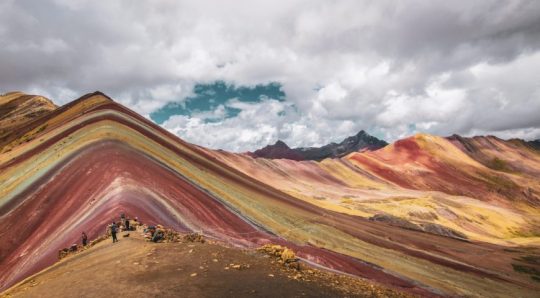
Welcome, fellow adventurers, to a virtual expedition to one of South America’s most captivating destinations – Peru! Known for its rich history, vibrant culture, and breathtaking landscapes, Peru has been captivating travelers for centuries. Today, we invite you to join us on an exciting adventure as we explore the must-visit spots on our Peru destination bucket list. But meanwhile, ensure to book your customized holiday package from Yashvi Tours and travels.
Let this vibrant country, with its rich tapestry of history and natural beauty, leave an indelible mark on your wanderlust-filled soul. The allure of Peru’s ancient ruins, captivating landscapes, and warm hospitality await you.
Lima: Where History Meets Modernity

Our journey begins in Lima, Peru’s lively capital city. Marvel at the blend of ancient and modern architecture as you explore the historic center, a UNESCO World Heritage site. Take the chance to visit the awe-inspiring Larco Museum, which houses a vast collection of pre-Columbian artifacts. Savor the diverse culinary scene, indulging in mouthwatering ceviche and other traditional Peruvian dishes.
Cusco: Gateway to the Inca Empire
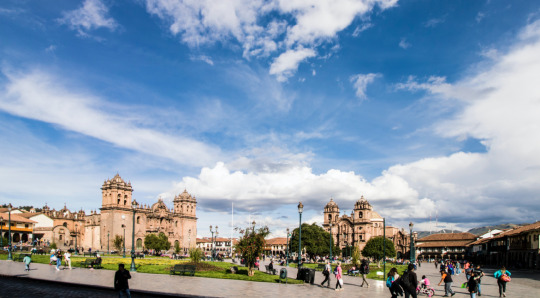
Next, we venture to Cusco, the historic heart of the Inca Empire. Immerse yourself in the mystical atmosphere as you stroll through the cobblestone streets lined with ancient Inca walls. Explore the mesmerizing ruins of Sacsayhuaman and the Sacred Valley, where you can witness the agricultural terraces and traditional Quechua communities. For adventure enthusiasts, a trek to the magnificent Machu Picchu is a must-do, providing a breathtaking view of this ancient wonder.
The Enigmatic Nazca Lines

Prepare to be awakened by the enigmatic Nazca Lines, one of the world’s greatest mysteries. These enormous geoglyphs etched into the desert floor are best viewed from above during a thrilling scenic flight. Marvel at the intricate designs of animals, humans, and geometric shapes, and let your imagination run wild with the theories behind their creation.
Arequipa: The White City

Our journey takes us to Arequipa, known as the White City, due to its beautiful colonial buildings made of white volcanic stone. Explore the stunning Santa Catalina Monastery, a city within a city where you can wander through its colorful streets and tranquil courtyards. Take advantage of the opportunity to savor the mouthwatering local dish, rocoto relleno, a stuffed spicy pepper that will ignite your taste buds.
Amazon Rainforest: A Biodiversity Hotspot

No visit to Peru is complete without delving into the mesmerizing Amazon Rainforest. Embark on an unforgettable adventure through the lush jungle, spotting vibrant wildlife and experiencing the unique ecosystem up close. Explore the Pacaya-Samiria Reserve, home to an incredible array of flora and fauna, and cruise along the Amazon River, immersing yourself in nature’s symphony.
Conclusion
Peru, with its diverse landscapes and rich cultural heritage, offers a truly unforgettable travel experience. Whether you’re an adventure seeker, history enthusiast, or nature lover, Peru will leave an indelible mark on your soul. To embark on your own Peru adventure, consider booking an international package with the best travel agency in Gandhinagar.
With their expertise and personalized service, they will ensure every detail of your trip is meticulously planned. Whether you desire a custom tour package or want to explore their range of tours and travels in Gandhinagar, they will make your travel dreams a reality.
Get ready to explore the wonders of Peru, where ancient civilizations meet breathtaking landscapes and where the spirit of adventure awaits at every turn. Happy travels!
Article Source : https://www.yashvitours.com/why-peru-destination-must-be-in-your-bucket-list/
0 notes
Text
The Most Anticipated Concert Tours of 2023
As the world slowly returns to a sense of normalcy, music lovers are eagerly anticipating the return of live concerts and tours. With many artists announcing their plans to hit the road in 2023, fans are already gearing up for what promises to be an unforgettable year of music.

One of the most exciting tours on the horizon is the Kenya Family Tours, which will take music fans on a journey through the vibrant and diverse music scene of Kenya. From traditional tribal music to modern hip-hop and pop, this tour promises to showcase the very best of Kenyan music and culture.
Another must-see tour is the Nile Cruise Family Tour, which will take fans on a musical journey down the iconic Nile River. Along the way, guests will be treated to performances by some of the biggest names in African music, as well as local musicians and dancers who will showcase the rich musical traditions of the region.
For those who love coffee and music, the Colombia Coffee Triangle Tour is a must-see event. This tour will take guests on a journey through the lush coffee plantations of Colombia, where they will be treated to performances by some of the country's most talented musicians. From traditional folk music to modern pop and rock, this tour promises to be a feast for the senses.
For those who love luxury and adventure, the United Arab Emirates Tours are sure to impress. This tour will take guests on a journey through the stunning landscapes and vibrant cities of the UAE, where they will be treated to performances by some of the biggest names in music. From world-famous DJs to local musicians, this tour promises to be an unforgettable experience.
Finally, for those who want to experience the very best of South America, the Luxury Private Tours Peru are a must-see event. This tour will take guests on a journey through the stunning landscapes and rich cultural heritage of Peru, where they will be treated to performances by some of the country's most talented musicians. From traditional Andean music to modern pop and rock, this tour promises to be a feast for the senses.
In conclusion, 2023 promises to be a year of unforgettable music and adventure. With so many exciting tours on the horizon, music lovers are sure to find something that speaks to their unique tastes and interests. Whether you're a fan of traditional music, modern pop, or anything in between, there's sure to be a tour that will take you on a journey you'll never forget.
More:
Jordan Vacation Tours
Egypt Family Tour
Peru Luxury Tours
South Africa Luxury Tours
Estonia Lithuania Latvia Tour
#Kenya Family Tours#Nile Cruise Family Tour#Colombia Coffee Triangle Tour#United Arab Emirates Tours#Luxury Private Tours Peru#Jordan Vacation Tours#Egypt Family Tour#Peru Luxury Tours#South Africa Luxury Tours#Estonia Lithuania Latvia Tour#Chile Vacation Tours
0 notes
Text
Frequently Asked Questions About Chivay
Traveling to Chivay, Peru is a great way to immerse yourself in the culture and history of this beautiful region. Located in the Colca Valley, Chivay offers visitors a wide variety of activities including outdoor adventures, cultural experiences, shopping opportunities, and delicious local cuisine. From exploring nearby pre-Incan ruins to trekking through lush valleys, there's something for everyone here. Whether you're looking for an exciting nightlife scene or a relaxing getaway from busy city life, Chivay has it all! So don't wait any longer – come explore this unique destination and create lasting memories! Happy travels!
When should I visit Chivay?The best time to visit Chivay is from May to October, when the weather tends to be dry and mild. During this time of year, temperatures range from highs of 70°F (21°C) during the day to lows around 40°F (4°C) at night. This season also coincides with Peru's peak tourist season, so expect larger crowds in town and along the trails. It is possible to visit in other months as well; however, winter can bring intense rainfall while summer temperatures often exceed 90°F (32°C). Regardless of when you go, make sure you bring warm clothing for cold nights and days spent at high altitudes.
Which area is good to stay in Chivay?The best area to stay in Chivay is the central district, which contains most of the town's attractions and services such as restaurants, hotels, shops, and banks. The streets here are lined with colonial-style buildings and cobblestone roads. Visitors will also find a number of outdoor activities nearby like river rafting, trekking, and horseback riding. Staying in this area puts you within walking distance of natural attractions like the Colca Canyon and thermal baths. Hotels range from budget-friendly lodges to luxury 5-star resorts.
What are the must-see attractions in Chivay?Popular attractions in Chivay include:1. The majestic Colca Canyon – the world's second deepest canyon, a popular spot for hiking and sightseeing.2. La Calera hot springs – natural thermal baths with spectacular views of the valley below.3. Cruz del Condor – get up close to the majestic Andean condors at this lookout point.4. Plaza de Armas – the main square in town where festivals and events are held throughout the year.5. Pinchollo Viewpoint – an impressive overlook that offers stunning views of snow-capped mountains and lush valleys.6. Ichupampa Archaeological Complex – explore ancient ruins from pre-Incan times.7. Mirador de Yanque – a lookout point that provides panoramic views of the valley.8. Valle del Arcoiris (Rainbow Valley) – a vibrant area near Chivay featuring colorful rock formations and diverse wildlife.9. Tiagano Market – shop for handmade crafts, local produce, and souvenirs at this bustling market.10. Plantations – explore the nearby plantations and learn about traditional methods of crop cultivation.Finally, there are also numerous festivals throughout the year where visitors can experience Peruvian culture and traditions firsthand.
Where can I find the best local food in Chivay?The best places to eat in Chivay include:1. El Huerto – a cozy family-run restaurant serving up delicious traditional Peruvian dishes.2. La Estancia – enjoy outdoor seating and a great view of the nearby mountains at this popular steakhouse.3. Café Andino – savor a cup of coffee or enjoy freshly baked pastries at this charming cafe.4. La Casa de la Papa – sample homestyle potato dishes in a rustic atmosphere.5. Centro Comercial Colinas del Colca – try some local favorites like llama skewers and empanadas at this food court.
Which places are best for shopping in Chivay?The best places to do shopping in Chivay include:1. Plaza de Armas – shop for souvenirs, traditional Peruvian clothing, and handmade crafts.2. Tiagano Market – explore the vibrant stalls of this bustling market and find unique items from local artisans.
3. La Giraldilla – take a step back in time at this colonial-style store traditional textiles and artisanal products.4. Centro Comercial Colinas del Colca – browse the numerous stores here for souvenirs and gifts.5. Las Trincheras – pick up locally produced food items like potatoes, spices, fruits, and vegetables.
What are the best nightlife options in Chivay?Good nightlife options in Chivay include:1. La Casa de la Papa – enjoy live music and dancing at this popular restaurant.2. El Huerto – listen to traditional Peruvian melodies while savoring a delicious dinner.3. Los Andes Pub – grab a beer and play some billiards at this lively bar.4. Puka Orcco Discotheque – dance the night away at this vibrant nightclub.5. Punto Natural Bar & Lounge – sip on your favorite cocktail or craft beer in a relaxed atmosphere.
What are the best day trips near Chivay?The best day trips near Chivay include:1. Cabanaconde – explore the dramatic canyon views and spot the majestic Andean condors.2. Yanque – take a stroll through this traditional Peruvian village and learn about local customs.3. Cotahuasi Canyon – marvel at some of the world's deepest canyons, as well as stunning waterfalls, hot springs, and lagoons.4. Llahuar Hot Springs – relax in the therapeutic waters of these natural springs surrounded by amazing scenery.5. Huambo Grande Waterfall – hike to this impressive waterfall and enjoy breathtaking views along the way.
0 notes
Text
Flavors of Lisbon: 15 Best Places to Eat in Portugal's Capital

Lisbon, Portugal, is a food lover's paradise with its diverse culinary scene and a plethora of excellent dining options. From traditional Portuguese cuisine to international flavors, Lisbon offers a wide range of restaurants, cafes, and markets that are sure to satisfy every palate. Here are some of the best places to eat in Lisbon, as recommended by travel and food experts.
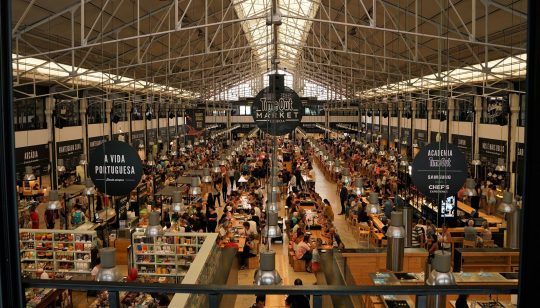
Time Out Market Lisbon: Located in the trendy Mercado da Ribeira, Time Out Market Lisbon is a bustling food hall that features some of the city's best food vendors all under one roof. With a wide variety of cuisines, including Portuguese, Mediterranean, Asian, and more, Time Out Market Lisbon offers something for everyone. It's a perfect spot for foodies to sample a diverse range of dishes in a lively and vibrant atmosphere.
Belcanto: As one of Lisbon's most renowned Michelin-starred restaurants, Belcanto offers a unique and sophisticated dining experience. Led by acclaimed chef Jose Avillez, Belcanto features a modern interpretation of traditional Portuguese cuisine, using locally sourced ingredients. With its elegant ambiance and exquisite dishes, Belcanto is a top choice for a special occasion or a memorable dining experience.
Ramiro: If you're a seafood lover, Ramiro is a must-visit restaurant in Lisbon. Known for its fresh seafood, particularly its famous grilled tiger prawns, Ramiro is a local favorite and has been serving delicious seafood for decades. The casual and lively atmosphere adds to the charm of this iconic Lisbon restaurant.

A Cevicheria: For a taste of Peruvian cuisine in Lisbon, A Cevicheria is the place to go. This trendy restaurant offers a contemporary take on ceviche, a popular dish from Peru made with raw fish marinated in citrus juices. A Cevicheria's creative ceviche combinations, along with its stylish decor and lively atmosphere, make it a popular choice among locals and visitors alike.
Taberna da Rua das Flores: This cozy and rustic tavern, tucked away in the narrow streets of Lisbon's Bairro Alto neighborhood, offers a true taste of traditional Portuguese cuisine. With a menu that changes daily based on what's fresh and in season, Taberna da Rua das Flores serves up delicious homemade dishes with a focus on local ingredients. The warm and welcoming ambiance makes it a perfect spot for a leisurely meal with friends or family.
O Talho da Esquina: For meat lovers, O Talho da Esquina is a carnivore's dream come true. This trendy restaurant offers a modern twist on the traditional Portuguese "talho" or butcher shop, with a menu that highlights different cuts of meat, cooked to perfection. From succulent steaks to flavorful sausages, O Talho da Esquina is a meat lover's paradise.
Ponto Final: For a unique dining experience with stunning views, Ponto Final is a hidden gem located across the river from Lisbon in Cacilhas. This waterfront restaurant offers panoramic views of Lisbon's skyline while serving up delicious Portuguese dishes. With its laid-back and charming ambiance, Ponto Final is a perfect spot for a romantic dinner or a relaxed lunch by the water.

Adega da Tia Matilde: This traditional Lisbon restaurant is known for its homestyle Portuguese dishes and warm hospitality. With a cozy and inviting atmosphere, Adega da Tia Matilde offers a range of classic Portuguese dishes, including grilled fish, roasted meats, and hearty stews. It's a great place to try authentic Portuguese comfort food and experience the warmth of Portuguese hospitality.
Cantinho do Avillez: Another culinary creation by renowned chef Jose Avillez, Cantinho do Avillez offers a casual and relaxed dining experience with a creative twist on Portuguese cuisine. The menu features a fusion of flavors, blending traditional Portuguese ingredients with modern techniques to create innovative and delicious dishes. With its cozy atmosphere and friendly service, Cantinho do Avillez is a popular choice for those looking for a contemporary dining experience.
Pastéis de Belém: No visit to Lisbon is complete without trying Portugal's most famous pastry, the Pastel de Belém. And the best place to enjoy these delectable custard tarts is at Pastéis de Belém, a historic bakery that has been serving them since 1837. Located in the Belém neighborhood, this iconic pastry shop is known for its flaky crusts, creamy fillings, and a sprinkle of cinnamon and powdered sugar on top. A visit to Pastéis de Belém is a must for any food lover looking to indulge in Portugal's sweet culinary delights.
Mercado de Campo de Ourique: This local market in Lisbon is a food lover's paradise, offering a wide range of culinary delights in a vibrant and lively atmosphere. From fresh seafood to gourmet burgers, artisanal cheeses to craft beers, Mercado de Campo de Ourique has something for everyone. It's a great place to sample different Portuguese flavors, interact with local vendors, and immerse yourself in Lisbon's food culture.
Sea Me: If you're a fan of seafood, Sea Me is a trendy and modern restaurant that should be on your list. Located in the Chiado neighborhood, Sea Me offers a wide selection of fresh fish and seafood, with a focus on quality and sustainability. From raw oysters to grilled fish, ceviche to sushi, Sea Me is a seafood lover's paradise with a contemporary twist.
Café Lisboa: As part of the historic Teatro Nacional de São Carlos, Café Lisboa offers a unique dining experience with its elegant decor and charming ambiance. Led by chef Jose Avillez, Café Lisboa serves up a fusion of Portuguese and Mediterranean flavors with a modern twist. From grilled octopus to roasted lamb, Café Lisboa offers a refined and memorable dining experience in the heart of Lisbon.

Tasca da Esquina: This cozy and unassuming restaurant is a hidden gem in Lisbon, known for its delicious Portuguese comfort food. Tasca da Esquina offers a menu that highlights traditional Portuguese dishes with a modern touch, using locally sourced ingredients. With its laid-back ambiance and friendly service, Tasca da Esquina offers a true taste of Portuguese hospitality and culinary heritage.
Adega Machado: For a taste of Lisbon's Fado culture, Adega Machado is a must-visit restaurant. This historic establishment is known for its live Fado performances, a traditional Portuguese music genre, while serving up delicious Portuguese cuisine. With its intimate and nostalgic ambiance, Adega Machado offers a unique dining experience that combines music, culture, and food in a truly Lisbon style.
In conclusion, Lisbon offers a vibrant and diverse culinary scene with numerous excellent dining options. From traditional Portuguese cuisine to international flavors, there's something for every food lover in Lisbon. Whether you're indulging in fresh seafood, trying creative fusion dishes, or exploring local markets, Lisbon's food scene is sure to impress. These are just a few of the best places to eat in Lisbon, offering a range of culinary experiences that will leave your taste buds satisfied and your memories filled with delicious moments.
Read the full article
0 notes
Text
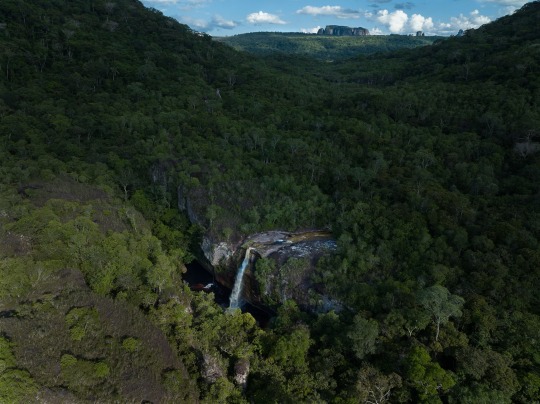
Chiribiquete National Park, the largest protected area in Colombia, is distinguished by its tepuis, tabletop peaks that rise abruptly from the rainforest. The area, with waterways that feed into the Amazon, is one of the world’s most biodiverse and is home to many unusual endemic species.
Rarely Seen Cliff Art Reveals The Majesty Of The Amazon’s Aquatic Realm
In a two-year expedition, a National Geographic photographer is documenting the mighty river and the greater ecosystem from the Andes to the Atlantic.
— Story and Photographs By Thomas Peschak | March 22, 2023
Two jaguars leap into the river, lunging at pacas. These oversize rodents, with blotched and striped coats, are agile swimmers. Piranhas, attracted by the commotion, hover nearby.
I’m photographing this riveting scene, but I’m not underwater as I usually am when I’m on assignment. Instead of diving to see this aquatic life, I’ve climbed to a rocky ledge far above a rainforest. The jaguars, pacas, and piranhas are not flesh and blood; they are prehistoric artworks painted with hematite, a blood-red iron oxide, in exquisite detail. I am in awe, as if seeing the ceiling of the Sistine Chapel for the first time.
These pictographs in Colombia’s Chiribiquete National Park, tens of thousands of years old, are evidence of humankind’s long relationship with the world’s greatest freshwater ecosystem. I’m part of the National Geographic and Rolex Perpetual Planet Amazon Expedition, working closely with other National Geographic Explorers doing critical research in the hope of securing the future of this watery realm, which has been neglected by science and the media.
The rainforests, an essential and endangered counterweight to climate change, have overshadowed the mighty river. From the Andes to the Atlantic, the Amazon flows for 4,150 miles, the main artery of a web with more than a thousand tributaries and tens of thousands of streams in an area the size of Australia. For two years, I will photograph the river, from high in the mountains to far out into the ocean. Unlike most storytellers who have ventured here, I will dive below the surface to reveal a rarely glimpsed aquatic underworld.

The National Geographic Society, committed to illuminating and protecting the wonder of our world, has funded Explorer Thomas Peschak's storytelling about the natural world since 2019. Illustration By Joe McKendry
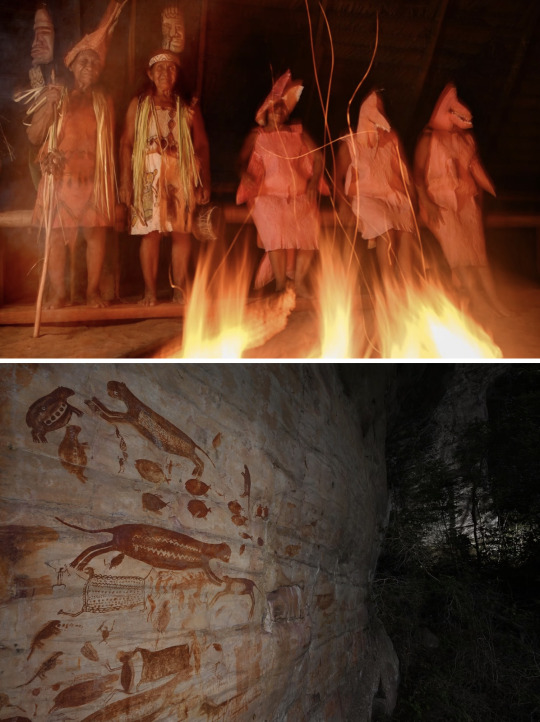
In the cosmology of the Tikuna, one of the largest Indigenous groups in the Amazon, pink dolphins are mischievous spirits and guardians of the watery realm. Elders Nuria Pinto and Pastora Guerrero join dancers wearing dolphin costumes made from the inner bark of the sapucaia tree. (Top)
Jaguars leap at pacas while piranhas swim on a panel known as “Hojarasca” (“Fallen Leaves”). More than 75,000 paintings have been discovered in Chiribiquete. Some are 20,000 years old, making them the most ancient rock art in the Americas. The pictographs show fauna and flora, people, and geometric patterns. Large jaguars and aquatic life are common motifs. (Bottom)
A few months ago, I photographed at my geographical starting point, the peak of Nevado Mismi in southwestern Peru, the farthest point from the Amazon’s mouth, where the waters flow uninterrupted all year. I’m in Chiribiquete to explore a different type of beginning and origin.
Here, the Amazon’s first storytellers painted the most ancient visual stories ever found in the Americas. More than 75,000 paintings have been discovered in more than 70 murals, cementing the park as the Louvre of rock art in the Americas. The pictographs include fauna and flora, people, and geometric patterns. Jaguars, sometimes life-size, are one of the most common motifs—each with a unique pattern of rosettes or lines.
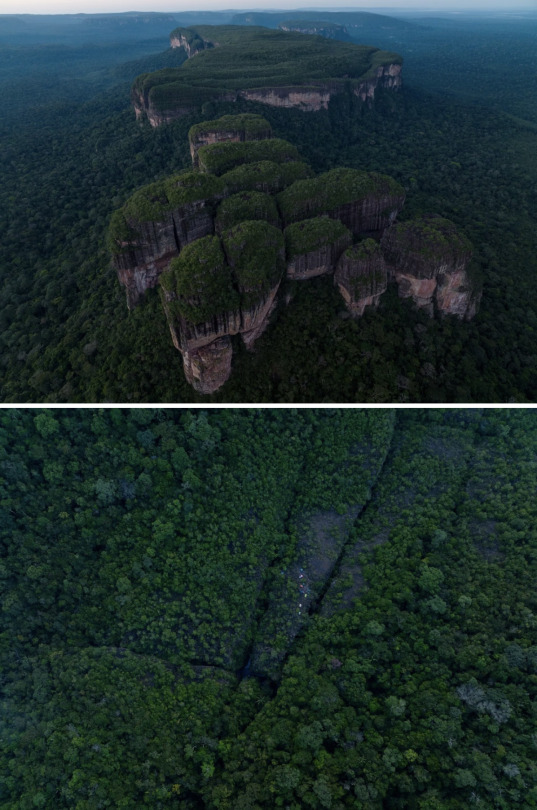
The ancient shaman artists chose the most spectacular locations to create their pictographs. The “Hojarasca” (“Fallen Leaves”) panel—the jaguars hunting pacas among piranhas—is located on the pillar at the far left, behind the one in the foreground. This expedition was only the ninth to be granted permission to explore the vast Chiribiquete National Park. (Top)
The expedition base camp was set up on a small patch of uneven rock that turns into a furnace during the day, with the solar-heated rock baking the air in the tents to more than 100 degrees Fahrenheit. The lack of shade and overwhelming number of sweat bees made the location nowhere near as idyllic as it first appeared. (Bottom)
I am with a small team, which includes aquatic biologist and National Geographic Explorer Fernando Trujillo and archaeologist Carlos Castaño-Uribe. A group of Colombian climbers and jungle specialists is with us so we don’t get lost in the trackless wilderness. We are only the ninth expedition to be granted permission to explore Colombia’s largest park, which protects a spectacular landscape of dense rainforest and soaring tabletop mountains called tepuis.
For 25 years I have documented our planet’s wildest seas, first as a marine biologist and later as a photojournalist. I am well versed in how not to get bitten by a shark or crushed by a feeding whale, but I am a neophyte in the jungle. In my defense, Chiribiquete is an incredibly difficult place to explore, and the ancient artists chose some of the most inaccessible locations.
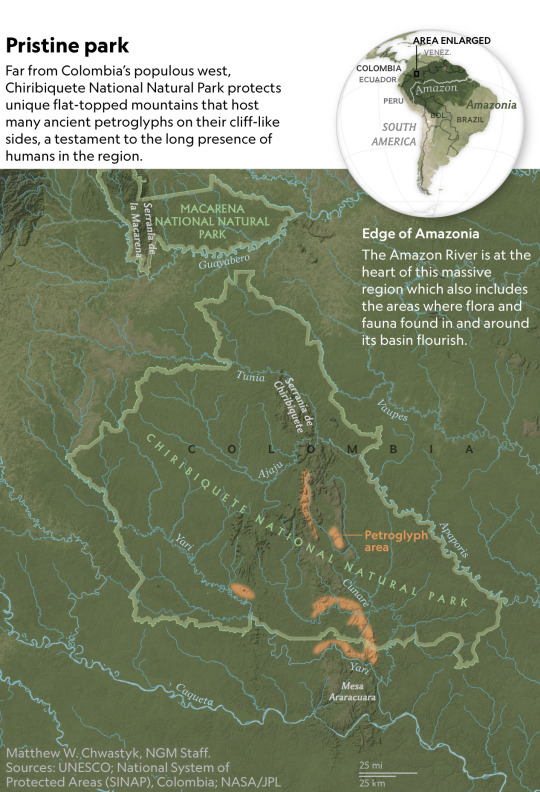
A Challenging Landscape
The helicopter takes off from the small airport of San José del Guaviare in south-central Colombia; the landscape below is a patchwork of cattle pastures and grasslands. Finally an unbroken carpet of pristine rainforest rolls out to the horizon. When the first mountains appear, the pilot descends, and we navigate through canyons so narrow that I can almost reach out and touch the cliffs. We land on a scrap of uneven rock. The helicopter barely fits.
The location appears idyllic, but it feels as if we’ve set up camp on a furnace. As the sun heats the rock, it bakes the air in our tents to more than 100 degrees Fahrenheit. I try to fall asleep, desperate for a breeze. My sweat forms wetlands on my mattress.
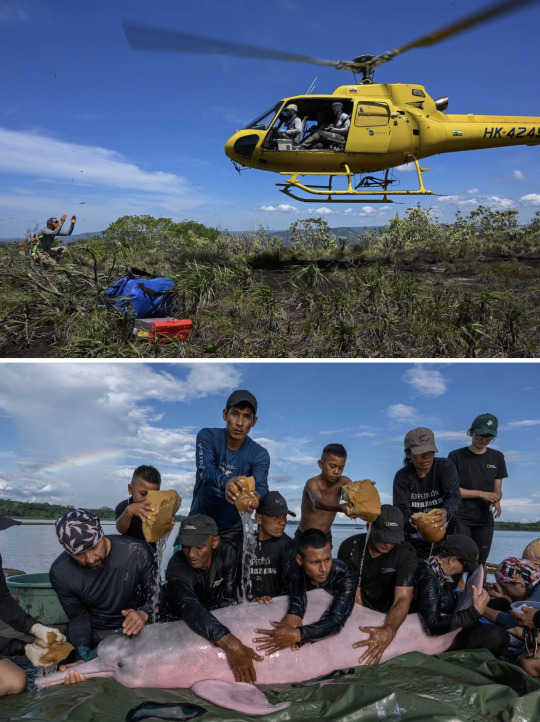
A helicopter is key to getting to and around Chiribiquete, as the terrain is extremely rugged and difficult to traverse on foot. To reach rock art painted in some of the most inaccessible places means rappelling down cliffs, bushwhacking through thick rainforest, and battling unrelenting bees. (Top)
National Geographic Explorer and scientist Fernando Trujillo (far left) and his team examine a boto, or pink dolphin, a keystone species in Amazonian rivers. Their assessments, which follow established safety protocols, provide critical information about the health of not only dolphin populations but also the rivers. (Bottom)
We wake to the sound of tens of thousands of tiny helicopters. The sweat bees are here. Soon the entire camp—camera cases, boots, clothing, plates, cutlery, anything left outside—is draped in bees. I make the mistake of leaving my tent zipper slightly cracked and before long end up with dozens of roommates. I let the bees quench their thirst from the sweat lake in my belly button. Resistance is futile. The bees overwhelm us. They crawl into our noses and ears; one even slips beneath my eyelid. A head net becomes mandatory.
The lowlands adjacent to rivers that flow through the park have hardly any sweat bees, but we were advised not to stay there. Remnants of FARC rebel forces are said to use these rivers when the water is high enough. I prefer bees to AK-47s.
Once, on an expedition in 2017, Trujillo woke in the early hours of the morning to the sound of footsteps. Thinking it was another researcher, he went back to sleep. The next morning, the scientists discovered smaller footprints, barefoot, in step with their boot prints. Indigenous Karijona, Murio, or Urumi people—uncontacted or living in isolation since violent encounters with rubber tappers in the 1800s—inhabit the headwaters of the park’s most important rivers. More than 50 miles of difficult terrain separate them from our campsite, but before falling asleep, I listen intently for the rustle of leaves or the crack of a twig.

Streams and rivers that flow from rocky plateaus run clear and are habitat for unique plants and animals. In the Serranía de la Macarena, a mountain range northwest of Chiribiquete, endemic Macarenia clavigera turns red in sunlight but remains green in shaded waterways. (Top)
A wolffish (Hoplias malabaricus) rests beneath a waterfall in the Caños Cristales River in the Serranía de la Macarena, obscured by a curtain of aerated water and camouflaged against a rocky ledge. This ambush predator waits for small schooling fish to swim within reach before lunging explosively and swallowing prey whole. (Bottom)
In the 1940s, Harvard ethnobotanist Richard Evans Schultes was the first scientist to note what he called Indian paintings on Chiribiquete’s cliffs. But he didn’t realize he was surrounded by one of the most extensive rock art repositories. This became apparent only in the 1980s when a storm pushed Castaño-Uribe’s Cessna off course and he spotted a mountain range that wasn’t on any of his maps. He returned to explore, saw the pictographs, and decided to devote his life to Chiribiquete. Not only did he publish the first detailed descriptions of the paintings and connect them to Indigenous cosmology, but he was also instrumental in the park’s establishment in 1989, expansions in 2013 and 2018, and selection as a UNESCO World Heritage site in 2018.
The oldest paintings here have been radiocarbon-dated to 20,000 years ago, but the youngest are from the 1970s, and compelling evidence shows that some are even more recent. On another expedition, Castaño-Uribe found a small hearth with animal bones and pigments beneath some paintings, indicating the art continues to be meaningful in Indigenous cosmology and ceremonial activities.
Hacking, Hiking, Rappelling
Before our expedition began, Castaño-Uribe consulted a shaman in the Sierra Nevada de Santa Marta, a mountain range near the Caribbean coast. To ensure a safe return and appease the spirits of the sites, the shaman advised him that we should make an offering of tobacco—sacred to many Amazonian Indigenous groups—before approaching the paintings. At the base of a sandstone tower, Castaño-Uribe passes around fat cigars that would not look out of place during a poker game. We puff vigorously, bathe ourselves in smoke, place our palms on the rock, and earnestly state our intentions. For extra measure, Castaño-Uribe exhales smoke over each of our heads.
Only then do we begin to explore.
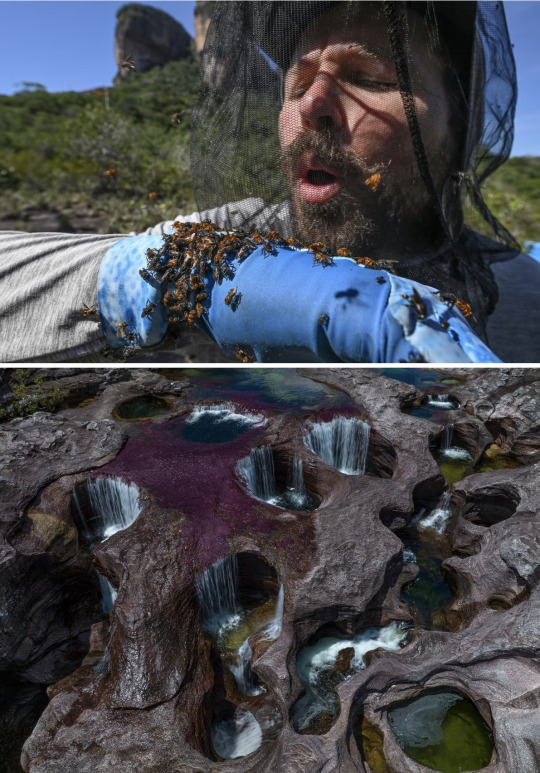
Sweat bees swarm videographer Otto Whitehead. Within minutes hundreds landed on him to lap up the nutrients and proteins in his perspiration. At least 11 species of the stingless bees abound on Chiribiquete’s tepuis. For this expedition a head net was essential gear. (Top)
The Caño Cristales carves these pits, known as giant’s kettles. They’re sculpted when hard pebbles fall into small cavities and are tumbled around by the current, over time scouring the cavity to form round pocks in the quartzite riverbed. (Bottom)
After hours of hacking through dense foliage, a dark canyon spits us out onto a narrow ledge next to a vertical cliff. We are at a site named “Los Gemelos” (“The Twins”). The rock art depicting stingrays, otters, and turtles is magnificent—and fiercely protected by bees. This time not the annoying stingless sweat bees but more virulent honeybees.
In less than half an hour the team collectively endures more than a hundred stings. We retreat, but the bees follow, and a rock wall that requires a fixed rope to climb becomes a bottleneck. Castaño-Uribe and I are waiting when he decides he has had enough of being stung. He bypasses the rope and, in a crouched run, scales the near-vertical 30-foot cliff, leaping from tree root to tree root, from branch to branch, Tarzan style. Not wanting to be left to the mercy of the belligerent bees, I follow, and despite being 15 years younger, I struggle to keep up.
Every morning we set out by helicopter and then on foot, climbing steep and densely forested slopes, rappelling down cliffs, and hauling ladders to navigate dark and damp canyons. Less than a half hour into one ascent I am close to collapsing because of my armored fashion choices. I’m layered up with thick combat pants, two shirts, gloves, a head net, and a pair of snakebite gaiters. I will do whatever it takes to protect myself from enemies, both real and imagined.
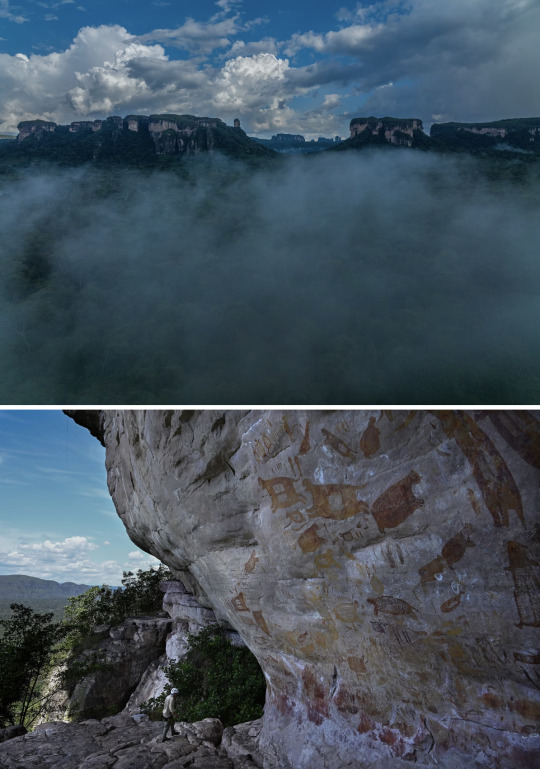
The park’s mountains soar from the rainforest floor, creating complex microclimates. Rising water vapor feeds the clouds, accelerating the formation of rain. More than half the precipitation in the Amazon stems from its own evaporation and transpiration. A fifth of the world’s fresh water is in the Amazon Basin. (Top)
Archaeologist Carlos Castaño-Uribe is dwarfed by a rock art panel named “Los Gemelos” (“The Twins”). These pictographs of jaguars, otters, stingrays, and turtles are stunning—and fiercely protected by honeybees. After enduring more than a hundred stings, the expedition team abandoned this site in a hurry. (Bottom)
The ferocious sting of bullet ants, a whopping 4 on the Schmidt pain index, is described as akin to walking across hot coals with a three-inch nail embedded in your heel. The potentially lethal fer-de-lance is responsible for most of the snakebites in the Amazon region. The bite of a female phlebotomine sand fly could infect me with disfiguring leishmaniasis. With every labored step in the stifling heat, I ask myself again and again what I’m doing in the Amazon.
I remind myself that this is just one chapter in my journey. Soon I will be back in my element, underwater, photographing species that are so outlandish that they could have been extras at the Star Wars cantina. Pink dolphins use sonar to navigate flooded woodlands. The arapaima, an armored fish that weighs as much as a silverback gorilla, leaps from the water like a marlin. Electric eels, like swimming batteries, deliver 600-volt shocks powerful enough to kill a human. Black freshwater stingrays with bright yellow spots rest in the leaf litter of drowned forest floors.
My National Geographic Explorer collaborators include some of the Amazon’s most accomplished scientists: Fernando Trujillo, João Campos-Silva, Ruthmery Pillco Huarcaya, Angelo Bernardino, Thiago Silva, Baker Perry, and Hinsby Cadillo-Quiroz. They’re doing groundbreaking work on pink dolphins, arapaimas, spectacled bears, mangroves, flooded forests, climate change, and mercury pollution. Next year, National Geographic will devote an entire issue of the magazine to the Amazon, featuring my photographs and their studies.
Finding Inspiration From the Earliest Amazon Artists
Famed 19th-century naturalists like Henry Walter Bates, Alfred Russel Wallace, and Alexander von Humboldt produced beautiful illustrations of what they had seen on their explorations in the Amazon River Basin. But I came to Chiribiquete to see the work of the first people in the Amazon to depict fauna and flora, specifically the aquatic animals I hope to photograph. On sheer rock walls, they painted fish, turtles, caimans, and other life-forms.
Over our five days in Chiribiquete, we saw hundreds of pictographs. The “Hojarasca” (“Fallen Leaves”) panel, with jaguars hunting pacas among piranhas, spoke to me the most. The way they’re painted on an overhang evoked the sense that I was underwater looking up as the scene played out above.

Lowland tapirs eat aquatic plants and walk underwater as hippos do. Juveniles have stripes and spots that help camouflage them. This one is a rescued orphan that will be rewilded. In between feedings, it’s free to explore forests and scrublands on a cattle ranch in the Serranía de la Macarena.
Castaño-Uribe thinks these paintings were likely made by shamans and played a role in religious rituals. Through the ingestion of sacred plants, Baniwa shamans believe they can transform into jaguars and talk with spirits. To the Tikuna, pink dolphins are sacred, feature in their dances, and are said to dwell in malocas, or longhouses, at the bottom of the river. Anacondas are often considered the creators of the universe, and a Desano legend tells of a giant snake that ascended the Amazon carrying the ancestors of all mankind on its back.
The shamans likely painted to communicate with supernatural beings to ensure balance between humans and the rest of nature. I tell stories because our relationship with Earth’s biodiversity urgently needs recalibration. The Amazon’s aquatic world is threatened by dams, mining, overfishing, pollution, and climate change. Gazing at these vivid, timeless pictures, I feel deeply connected to these artists and their paintings. I realize we are telling similar stories, and I hope my images stand the test of time even a fraction as well as theirs.
1 note
·
View note
Note
hello I would like to inquire about “sometimes characters …that aren’t narrators…are better” and also “hbd zainab 2022” if I am allowed a second one
“sometimes characters …that aren’t narrators… are better”
this is my google doc dumping ground for all my random Raphael POV versions of scenes from The Bedlam Stacks (the title is a joke and means no disrespect towards actual narrator Merrick Tremayne, who is my baby boy forever). There’s only two entries in there now. One is a scene from before Merrick and Clem arrive in Peru, between Inti and Raphael at church. The other is Raphael’s POV on the Tent Scene™️, because duh. Here’s an excerpt from the second one:
“As he shifts on the ground, trying to get comfortable, some stray motes illuminate the scars on Merrick’s back, pulled taut as he sleeps curled in on himself. Without realizing, Raphael has stretched out his hand to bring his fingers close enough to trace the marks. He stops himself at the last possible moment, his fingertip hovering just above the skin. If Merrick had been awake, it would have been close enough to feel, but thankfully, he isn’t and Raphael is spared the embarrassment of having to explain himself. He’s not sure he could have even if he wanted to.
Merrick was casual enough about the scars that day by the river, but Raphael doesn’t like the reminder that they exist. He doesn’t like to think of Merrick in pain, of all the different ways the world tried to beat him into shape and turn him into a weapon against somebody somewhere. He doesn’t like the reminder of Markham, now dead and buried in the Bedlam churchyard, the last place on earth he probably expected to end up. Merrick said he was important, from a good family, which means there’s probably a fancy mausoleum somewhere in England that will always be emptier than it’s supposed to be. Beyond that piece of information, Merrick has hardly talked about Markham since Martel showed up, but Raphael can’t imagine the death of his friend, no matter how complicated the circumstances, isn’t weighing on him.”
“hbd zainab 2022”
Can’t believe you ranked this one second in your priorities, but okay. So, my original plan for your birthday fic was not the prompt fill I ended up posting, but instead it was Modern AU for Rogue One where the gang is playing in a DnD campaign run by Bodhi, who’s getting practice as a DM before he plays the game with his students. Definitely not based on anyone I know or anything ;) I didn’t get very far with it, but here’s a bit from the beginning:
“I was hoping you’d be willing to play,” Bodhi says.
“Oh, Bodhi, I—I wouldn’t be any good at that! It’s like…nerd shit.”
He gives her an unimpressed look at that. “Jyn, you love Tolkien and T.H. White and Le Guin and all that shit. You love video games. You have a Twitch, for God’s sake. You love nerd shit!”
“Yeah, but I mostly have a Twitch so I can get into fights with lonely, stupid men on the internet,” she says. “Besides, I’ve never played Dungeons and Dragons before!”
“Which means you’ll be in the same boat as most of my students,” Bodhi points out. “And therefore your input will be very valuable to me.”
“You can’t find anyone else to be your newbie?”
“Well, Chirrut insists he’s never played before, but Baze insists he actually has. Either way, it was the 80s, so the rules have changed a lot since then, so he will basically be a new player. And it’s been a while for Baze too, but I know he watches Critical Role sometimes, so he’s more current on the rules and everything. And Cassian’s played a lot and been a DM plenty of times before, so he has a lot of experience—”
#thank you zainab you thoughtful bioluminescent angler fish#Bodhi’s dnd campaign was supposed to basically be the actual plot of rogue one#with their player characters breaking Jyn out of prison and trying to find her father to stop a power hungry villain#is it any wonder I stalled out on it??#anyway#here’s wonderwall#wip game#ask game#firstelevens
10 notes
·
View notes
Text
Police losing narco war in deadly Amazon region where duo disappeared
A key police outpost lies in ruins after a daring raid – a sign of the growing danger on an increasingly lucrative smuggling route

In the crime-infested tri-border region where Dom Phillips and Bruno Pereira disappeared, rumours abound over what happened at Puerto Amelia in January this year.
Were Brazilian drug traffickers responsible for burning the Peruvian police outpost on the River Yavarí to the ground?
Was it Colombian guerrillas who stormed the camp, shooting at the border guards and making off with their high-powered weapons?
Or were the culprits rogue Peruvian police officers, perhaps working for organized crime?
The answer depends on who you talk to – but the consequences were the same.
Five months after the audacious raid, the camp lies in ruins. Charred logs are the only remnant of a turquoise lodging the Peruvian troops had called home.
Filing cabinets and metal bunk beds are scattered in the undergrowth while the ground is littered with empty cans of tuna fish and spam. Tiger orange butterflies dance around an abandoned border marker, bringing colour to an otherwise desolate scene.
“They took guns, rifles, bullets, the lot,” said one local, who gave the Guardian a tour of the strategically positioned base, located opposite the entrance to the River Itaquaí, where Phillips and Pereira are feared to have been murdered.
The local said the security situation had been deteriorating since 2020 as Latin American drug cartels and factions fought for control of this increasingly lucrative smuggling route.
“This is what the region is like now,” they sighed as they surveyed the deserted police position past which boats packed with drugs can now travel undisturbed. “It didn’t use to be like this.”
But this is not the first such attack on the feeble law enforcement in the Amazon region where Peru meets Colombia and Brazil.
“The narcos are bolder, more aggressive; they have attacked three police posts in the last five years,” a Peruvian anti-narcotics officer said.
Continue reading.
#brazil#brazilian politics#politics#environmental justice#peru#peruvian politics#amazon rainforest#indigenous rights#international politics#public security#drug trafficking#mod nise da silveira#image description in alt#dom phillips#bruno araujo pereira
2 notes
·
View notes
Text
@edisonblog The Moche Culture, also known as the Mochica Culture, was an ancient pre-Columbian civilization that flourished on the northern coast of Peru between AD 100 and 800. Its territory covered what is now part of the departments of La Libertad and Lambayeque. The Mochicas were an advanced people who made great advances in various fields, leaving behind a significant cultural and archaeological legacy.
Among the most outstanding characteristics of the Moche Culture are:
Exceptional ceramics: The Mochicas were masters of ceramics. They created beautiful decorative and utilitarian pieces, often representing scenes from daily life, religious ceremonies, anthropomorphic and zoomorphic figures, and portraits of important people. Their ability to sculpt in clay allowed them to capture realistic and expressive details.
Complex engineering works: The Mochicas built irrigation systems to take advantage of the water from the rivers and ensure the irrigation of their agricultural fields. This allowed them to develop an economy based on agriculture and fishing.
Art and religion: Religion played an important role in the life of the Mochicas. Their art was heavily influenced by their beliefs, and they represented their gods, priests, warriors, and mythological beings in their ceramics and murals.
Hierarchical society: Mochica society was structured into social classes, with a ruling elite that held political, religious, and military power. The rulers were considered demigods and their authority was centralized.
Advances in metallurgy: The Mochicas were also expert metallurists and worked with gold, silver, and copper. They created ornaments, jewelry and ceremonial objects with great skill.
Funeral complexes: The Mochicas built adobe pyramids known as "huacas" that served as funerary complexes and ceremonial centers. In these huacas, they buried their rulers and elite, accompanying them with rich treasures and offerings.
Although the Moche Culture disappeared more than a thousand years ago, its cultural legacy has been rediscovered and studied by modern archaeologists and historians. Its impressive artistic and technological achievements continue to amaze the world and provide valuable insights into the region's rich pre-Columbian history.
#edisonmariotti Edison Mariotti Edison Mariotti
by by Alejandro A Mendoza
link: https://shre.ink/aF6Z
.br
A Cultura Moche, também conhecida como Cultura Mochica, foi uma antiga civilização pré-colombiana que floresceu na costa norte do Peru entre 100 e 800 DC. Seu território cobria o que hoje faz parte dos departamentos de La Libertad e Lambayeque. Os Mochicas foram um povo avançado que fez grandes avanços em vários campos, deixando um legado cultural e arqueológico significativo.
Entre as características mais marcantes da Cultura Moche estão:
Cerâmica excepcional: Os Mochicas eram mestres da cerâmica. Eles criaram belas peças decorativas e utilitárias, muitas vezes representando cenas da vida cotidiana, cerimônias religiosas, figuras antropomórficas e zoomórficas e retratos de pessoas importantes. Sua capacidade de esculpir em argila permitiu-lhes capturar detalhes realistas e expressivos.
Complexas obras de engenharia: Os mochicas construíram sistemas de irrigação para aproveitar a água dos rios e garantir a irrigação de seus campos agrícolas. Isso lhes permitiu desenvolver uma economia baseada na agricultura e na pesca.
Arte e religião: A religião desempenhou um papel importante na vida dos Mochicas. Sua arte foi fortemente influenciada por suas crenças, e eles representavam seus deuses, sacerdotes, guerreiros e seres mitológicos em suas cerâmicas e murais.
Sociedade hierárquica: A sociedade mochica era estruturada em classes sociais, com uma elite dirigente que detinha o poder político, religioso e militar. Os governantes eram considerados semideuses e sua autoridade era centralizada.
Avanços na metalurgia: Os Mochicas também eram metalúrgicos especializados e trabalhavam com ouro, prata e cobre. Eles criaram ornamentos, joias e objetos cerimoniais com grande habilidade.
Complexos funerários: Os Mochicas construíram pirâmides de adobe conhecidas como "huacas" que serviam como complexos funerários e centros cerimoniais. Nessas huacas enterraram seus governantes e elites, acompanhando-os com ricos tesouros e oferendas.
Embora a Cultura Moche tenha desaparecido há mais de mil anos, seu legado cultural foi redescoberto e estudado por arqueólogos e historiadores modernos. Suas impressionantes realizações artísticas e tecnológicas continuam a surpreender o mundo e fornecem informações valiosas sobre a rica história pré-colombiana da região.
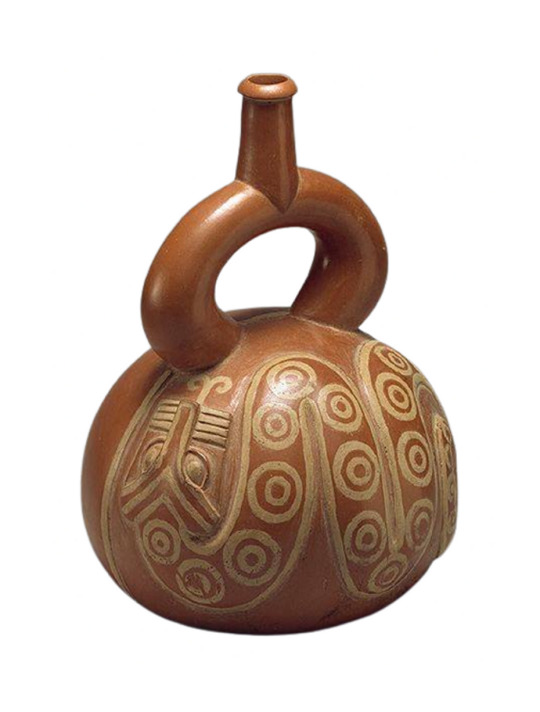
0 notes